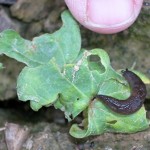UT Cotton Scout School on Friday, May 25th at the West Tennessee Research and Education Center in Jackson. Registration will begin at 8:00 AM (no fee or preregistration required). The program will end with a box lunch and a go-to-the-field session for those interested after lunch.
All posts by Scott Stewart, West TN Research & Education Center
Bugs of the Week
Overall, I’m not getting any reports of widespread problems in any crop, but there has been a smattering of several things including … Continue reading
Armyworm Action in Wheat is Picking Up
I’ve had calls about cutworms and slugs this week. You can see my comments about slugs in last week’s post (link here). However, the most common question has been on armyworms in wheat. Calls have varied from low populations, but some with head clipping, to high populations that have caused severe defoliation. The picture below is that of near complete defoliation, including the beards of wheat, from Crockett County. Continue reading
New Cotton Production Fact Sheets
Two new Cotton Production Fact Sheets are available as web based documents. Continue reading
Cotton Planting Forecast
“Planting cotton is the second great urge known to man.” I am not sure who to accurately attribute that quote to, but I have heard it several times from Dr. Will McCarty, former Extension Cotton Specialist at Mississippi State University. Continue reading
Nitrogen for Cotton
Many, many questions have been received over last week about how to manage the supply of nitrogen in light of more acres of early planted corn, and the need to plant cotton. While all forms nitrogen may not be readily available we need to keep perspective on our options. Continue reading
Slugs in Corn and Other Crops; Armyworms in Corn
 Slugs. There have been a few calls about slug feeding in corn, and I would expect some similar calls in other crops as they emerge. Slugs, unlike snails, lack shells and commonly feed on plants. They feed on leaves and sometimes cut the stems of cotton or soybean seedlings similar to cutworms. Snails rarely cause economic damage to field crops, and the ones typically encountered do not even feed on the plants. There are no Continue reading
Slugs. There have been a few calls about slug feeding in corn, and I would expect some similar calls in other crops as they emerge. Slugs, unlike snails, lack shells and commonly feed on plants. They feed on leaves and sometimes cut the stems of cotton or soybean seedlings similar to cutworms. Snails rarely cause economic damage to field crops, and the ones typically encountered do not even feed on the plants. There are no Continue reading
The Bug Front is Mostly Quiet
Armyworms in Wheat – Unlike some areas to our south, there have been very few calls on armyworms. Granted, many people included an insecticide with their fungicide, but the few reports of those that didn’t indicate that armyworms are not an issue. I have not found armyworms in the wheat at the Jackson experiment station. Dr. Angus Catchot did an excellent podcast about the treatment threshold for armyworms in Mississippi, which is essentially the same as ours (link here). Cereal leaf beetles also Continue reading
